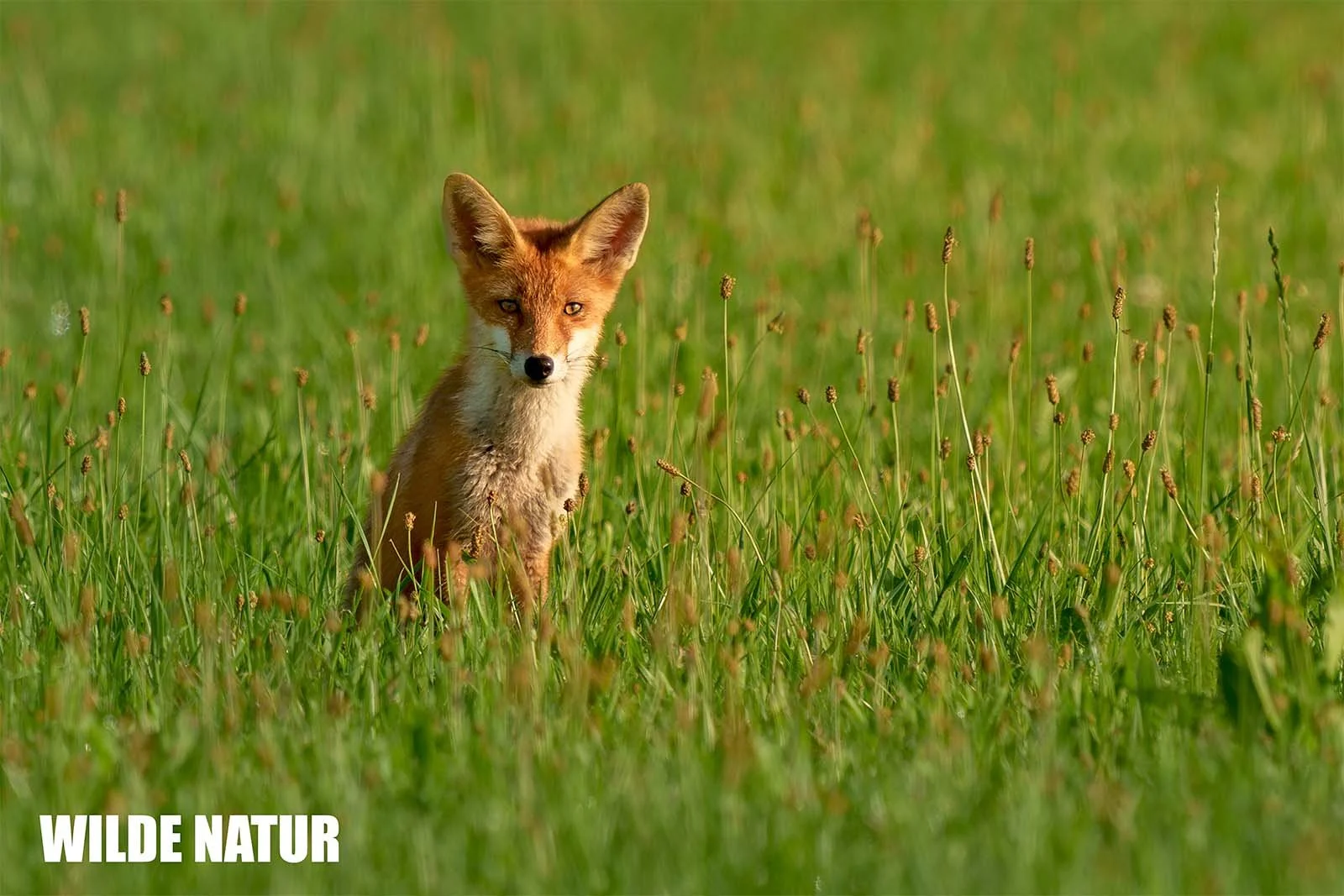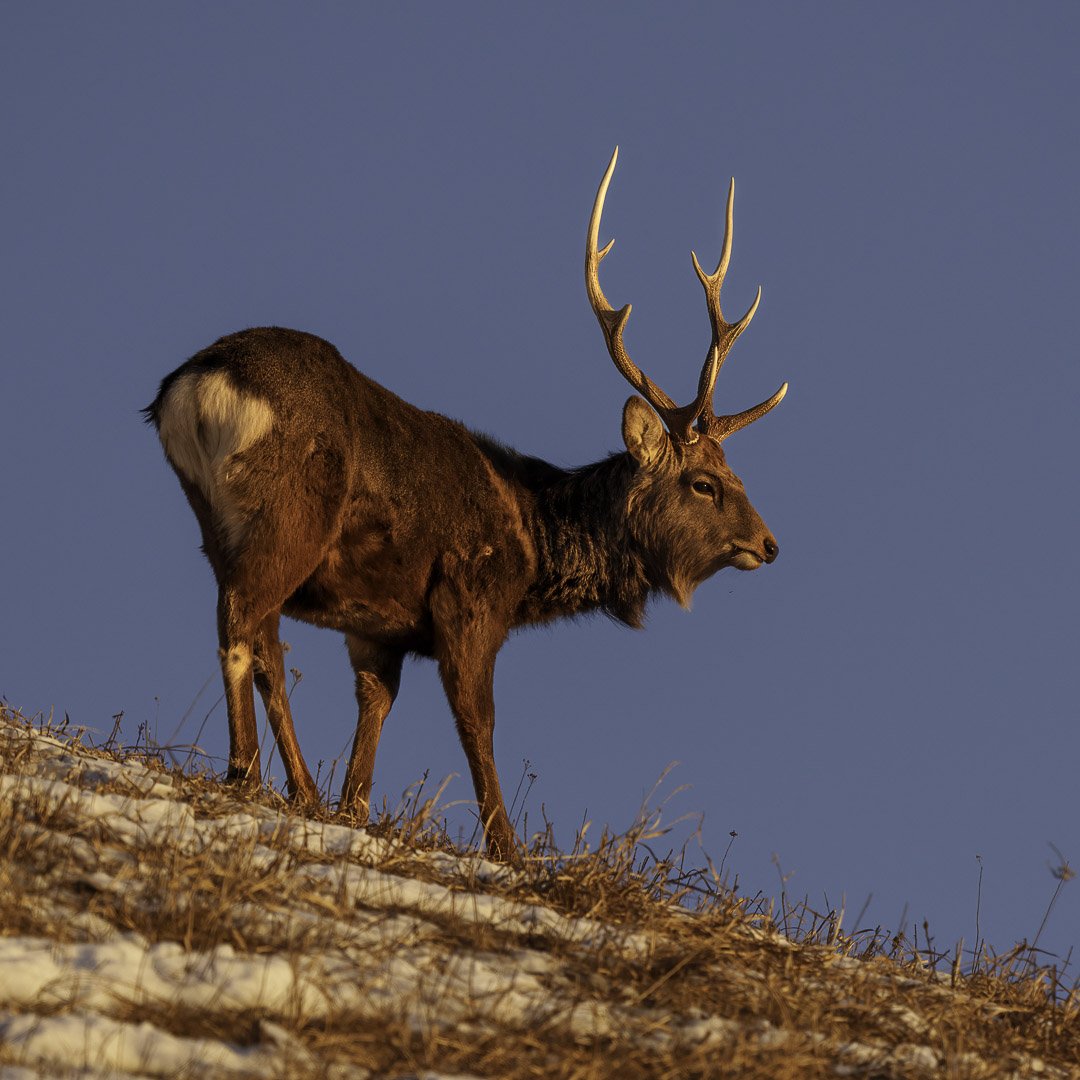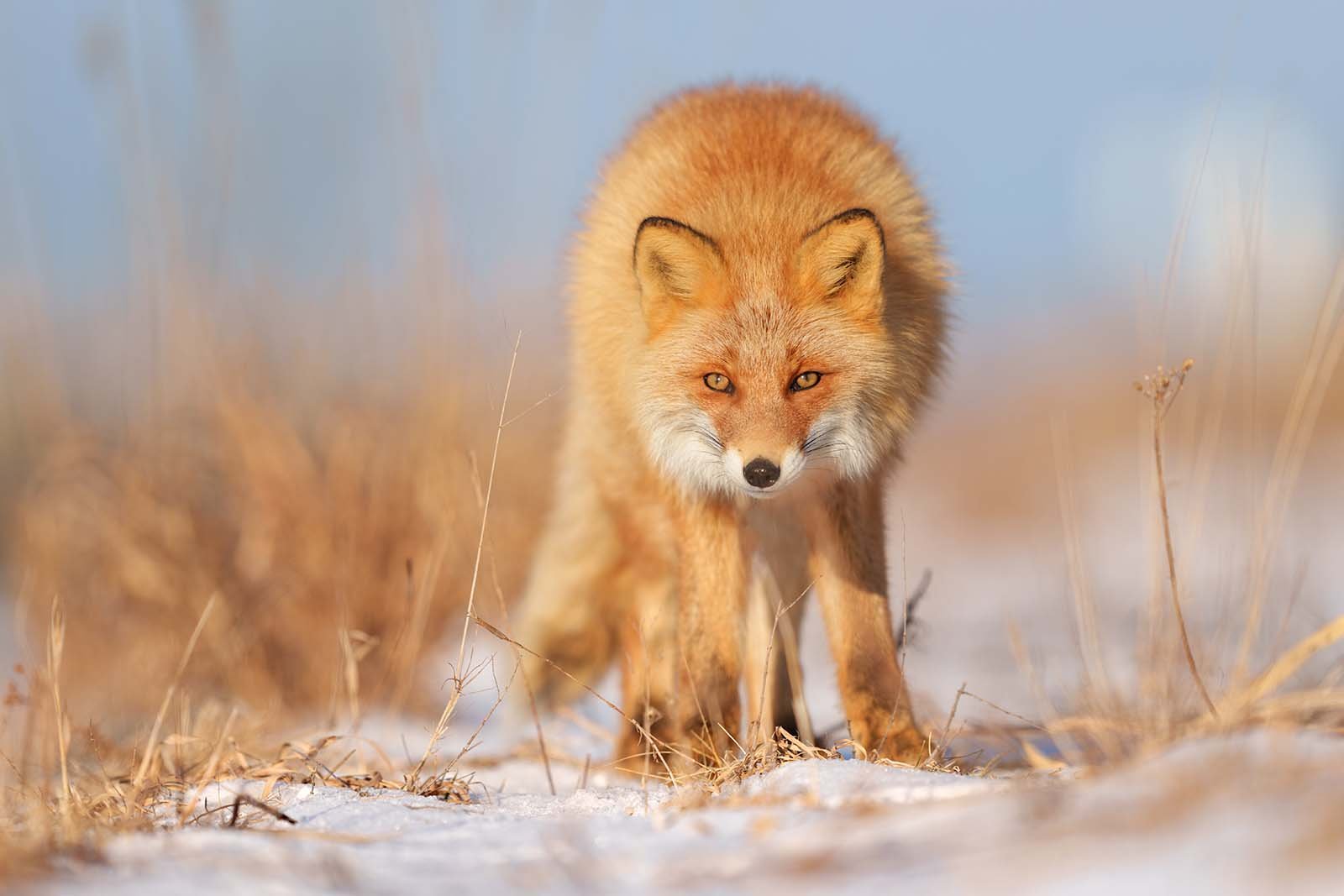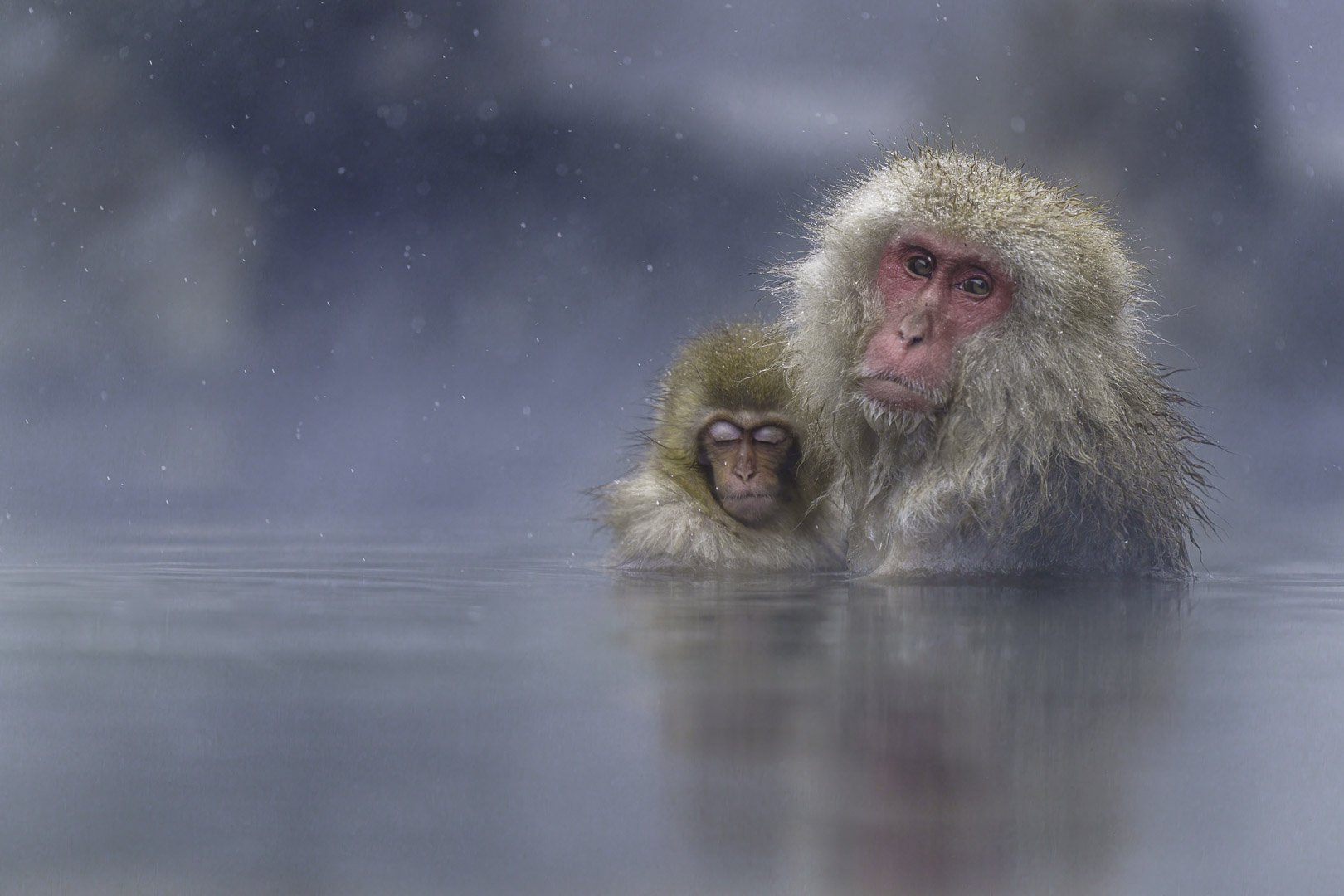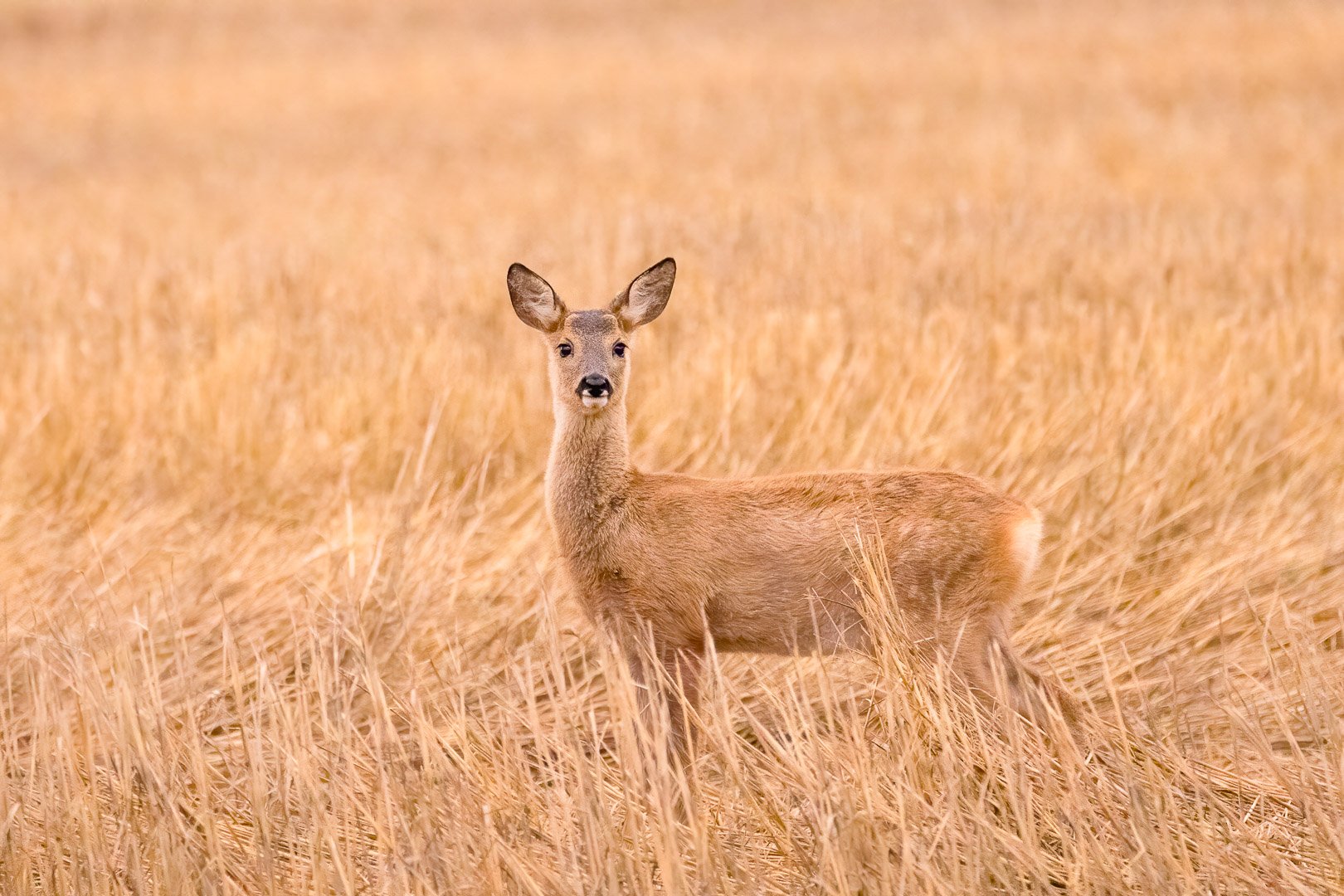Red deer (Cervus elaphus)
Red deer at dawn during the rutting season
Red Deer (Cervus elaphus): A Wild Animal with Antlers and Secrets
The red deer is the king of the forest – adaptable, shy, and impressive. Discover its lifestyle, mating season, diet, and tips for observing it in this profile.
- Largest native wild animal in Germany, weighing up to 350 kg (770 lbs)
- Only males grow large antlers
- Now mainly lives in forests, though originally a steppe animal
- Excellent senses: can detect danger from hundreds of meters away
- Eats up to 20 kg (44 lbs) of plants daily – plays an important ecological role
- Spectacular rutting season in autumn, with loud roaring
- Hard to photograph – but every sighting is a special experience
Key Facts
- Species name: Cervus elaphus
- Nickname: Noble deer
- Size: 165–205 cm body length (5.4–6.7 ft)
- Weight: 100–113 kg (220–250 lbs) in Central Europe
- Antlers: only on males, up to 140 cm (4.6 ft) long
- Habitat: Forests with clearings and dense undergrowth
- Diet: Grasses, herbs, twigs, bark, mushrooms, moss
- Range: Europe, Asia, North Africa, New Zealand
- Activity pattern: Mainly active at dawn and dusk
Table of Contents
- Introduction
- Habitat: From Steppe to Forest
- Body: Bulk with Stamina
- Senses: Four-Legged Early Warning System
- Diet: Nothing Too Tough
- Rutting Season: Loud, Wild, and Powerful
- Antlers: A Bone Marvel
- Threats & Protection: No Place for a King?
- Observation & Photography: The Smart Approach
- FAQ – Frequently Asked Questions
Introduction
When a deep roar echoes through the forest in autumn, it’s clear: the red deer is here. Powerful, cautious, and majestic, it moves through the underbrush. Its antlers aren’t just heavy – they carry meaning. But anyone who thinks this giant is clumsy or slow greatly underestimates it.
Though mostly hidden from view, the red deer shapes entire ecosystems. Its behavior tells us a lot about the health of our forests – and our relationship with nature.
Habitat: From Steppe to Forest
Red Deer (Cervus elaphus) - Picture taken at Darß Zingst, Mecklenburg-Western Pomerania, Germany
Originally, red deer lived in open landscapes. But due to human influence and the fragmentation of nature by roads, villages, and cities, they have adapted – today, they are mostly found in structured forests.
They prefer areas where dense underbrush offers protection and clearings provide food. Red deer don’t need wilderness, but they do need undisturbed retreats. That’s why many German states limit red deer populations to special zones called red deer districts. Outside these areas, they are often either protected year-round or not wanted at all.
Body: Bulk with Stamina
Red deer are impressive animals with powerful bodies. While Sardinian deer weigh only about 80 kg (176 lbs), those in the Carpathians can reach over 300 kg (660 lbs). A ten-year-old stag in the Harz region usually weighs 100 to 113 kg (220–250 lbs).
Despite their size, they are surprisingly agile. They move silently through forests, easily overcome obstacles, and can sprint faster than many joggers over short distances.
Senses: Four-Legged Early Warning System
Red deer don’t have eagle-sharp vision – but they can see all around them. Their side-positioned eyes give them a wide field of view. And that’s just the beginning:
- Sense of smell: They can detect predators hundreds of meters away – even against the wind. They lift their heads, open their mouths slightly, and move their nostrils like a tracking dog.
- Hearing: Their ears rotate independently. A rustle in the bushes? A step on dry leaves? The deer hears it – long before you see them.
Diet: Nothing Too Tough
An adult red deer eats 8 to 20 kilograms (17–44 lbs) of plant material per day. Their diet is diverse:
- Grasses and herbs
- Tree bark and young twigs
- Fruits, mushrooms, mosses, and lichens
Their rumen (a stomach compartment) holds up to 25 liters, allowing them to digest even high-cellulose foods like bark in winter. They avoid only a few plants, such as some thistles or sedges.
Through their feeding, red deer help shape which plants dominate the forest. Their eating habits influence the ecosystem – for better or worse.
Rutting Season: Loud, Wild, and Powerful
As autumn begins, the forest becomes a stage. The rutting season is a dramatic display – loud, physical, and full of energy.
- Stags roar to impress rivals and attract females.
- Fights for harems are common – their powerful antlers are the main weapons.
- During this time, they barely rest – food and safety take a back seat.
Body language, scent, and sound dominate. After mating, the harems dissolve – and normal life resumes.
Antlers: A Bone Marvel
Antlers are not just for show – they are a biological masterpiece. Made of up to 5 kg (11 lbs) of bone, they regrow each year – in just about 140 days. The largest can weigh over 20 kg (44 lbs).
A striking example: In 2014, a stag with 15.55 kg (34.3 lbs) antlers was observed in the Duvenstedter Brook near Hamburg.
The antler cycle follows a clear pattern:
- Shed in February
- Regrowth through spring
- Fully grown antlers by the rut in late summer
Antlers signal a stag’s age, strength, and rank – not just to rivals, but also to potential mates.
Threats & Protection: No Place for a King?
Despite their strength, red deer are under pressure. The main problem: fragmented habitats. Highways, settlements, and wind farms break up the forest. Retreat areas are shrinking.
In many areas, deer are limited to designated zones. Within these, they are allowed to live – and are often also hunted. Outside them, they may be either unwanted or strictly protected.
This balancing act sparks debate: How much wildlife can the forest handle? And how much forest does the wildlife need?
Observation & Photography: The Smart Approach
Seeing a red deer is a rare treat. They are usually shy and cautious, avoiding people. But you can improve your chances:
- Get up early: They are active at dawn.
- Stay quiet: Avoid noise and sudden movements.
- Watch the wind: Always stalk against the wind.
- Choose the right spot: Forests with clearings and open lines of sight work best.
Photo tip: Use a telephoto lens of at least 600 mm. Expect to spend more time waiting than shooting – but every encounter is worth it.
FAQ – Frequently Asked Questions
How can I identify red deer tracks in the forest?
Look for large, elongated hoof prints, droppings shaped like walnut-sized pellets, and bark stripped from tree trunks at chest height.
Do female red deer have antlers too?
No. Only males – the so-called Kahlwild (females and young) remain antlerless.
When is the best time to spot a red deer?
Early morning or at dusk, especially in autumn during the rutting season.
How long does a red deer live?
In the wild, usually 12–15 years. In enclosures, they can live much longer.
Why do stags roar?
Roaring serves to mark territory, intimidate rivals, and attract females.







